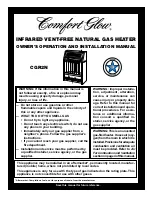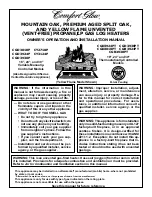
6 720 608 263
2
Index
Index
1
Warning 2
2
Appliance details
4
2.1
Features 4
2.2
2400 E Specifications (Technical data)
4
2.3
Unpacking the 2400 E heater
5
2.4
General rules to follow for safe operation
6
2.5
Dimensions and Minimum installation clearances
7
3
Installation instructions
8
3.1
Introduction 8
3.2
Proper location for installing your heater
8
3.3
Heater placement and clearances
8
3.4
Mounting installation
8
3.5
Combustion air requirements
9
3.6
Venting
11
3.6.1
Vent material and specifications
11
3.6.2
Vent connections
12
3.6.3
Condensate drain tube requirements
13
3.6.4
Room sealed installation (Twin pipe)
13
3.6.5
Vertical terminations
14
3.6.6
Horizontal terminations 15
3.6.7
Exhaust vent configuration examples
18
3.7
Gas piping & connections
19
3.8
Measuring gas pressure
21
3.9
Water connections
22
3.10
Electrical connections
23
3.11
Cascading function
23
3.12
Recirculation application
23
4
Operation instructions
24
4.1
For your safety, read before operating your water heater
24
4.2
Power 24
4.3
Temperature selection
25
4.4
Use of optional remote control accessory
27
4.5
Operation 27
4.6
Reset button
27
4.7
Program button
27
4.8
Locked condition
27
5
Maintenance and service
28
5.1
Annual maintenance
28
5.2
Winterizing for seasonal use
28
5.3
Mineral scale build-up
29
5.4
Adjusting CO2
29
5.5
Control board diagnostics
32
6
Troubleshooting 33
6.1
Introduction 33
6.2
Burners do not ignite when hot water is turned on
33
6.3
Water is too hot
33
6.4
Water is not hot enough
33
6.5
Low water flow/pressure
34
6.6
Hot water temperature fluctuates at tap
34
6.7
Noisy burner/heater during operation
34
6.8
Error code diagnostics
36
7
Electrical diagram
41
8
2400 E Functional scheme
42
9
Interior components diagram and parts list
43
9.1
Interior components
43
9.2
Components diagram
44
9.3
Parts list
45
10
Protecting the environment
46
11
Fifteen Year Limited Warranty
47
1
Warning
For your safety
Do not store or use gasoline or other flammable,
combustible or corrosive vapors and liquids in the
vicinity of this or any other appliance.
Warning:
Carefully plan where you
install the heater. Correct combustion
air supply and flue pipe installation are
very important. If a gas appliance is not
installed correctly, fatal accidents can
result from lack of air, carbon monoxide
poisoning or fire.
Warning:
Exhaust gas must be vented
to outside using proper vent material
suitable for category III vent systems
and temperatures up to 480°F. Vent
and combustion air piping must be
sealed gas-tight to prevent possibility of
flue gas spillage, carbon monoxide
emissions and risk of fire, resulting in
severe personal injury or death.
Warning:
Place the heater in a location
where water leaks will do NO DAMAGE
to adjacent areas or lower floors.
Warning:
Field wiring connections and
electrical grounding must comply with
local codes, or in the absence of local
codes, with the latest edition of the
National Electric Code, ANSI/NFPA 70,
or in Canada, all electrical wiring must
comply with the local codes and the
Canadian Electrical Code, CSA C22.1
Part 1.
Warning:
Shock hazard: line voltage is
present. Before servicing the water
heater, unplug power supply cord from
outlet. Failure to do so could result in
severe personal injury or death.
Warning:
The heater must be
disconnected from the gas supply
piping system during any pressure
testing of that system at test pressures
equal to or more than 0.5 psig.



































